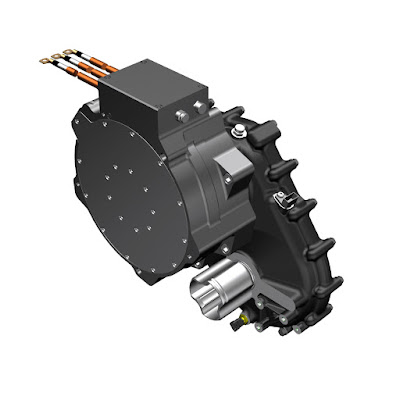Xtrac’s P1227 gearbox family has been developed to address the growing market requirement for single speed, lightweight and power dense electric vehicle (EV) transmissions. It offers a range of installation possibilities for fast and powerful electric supercars with front-wheel drive, rear wheel drive or four-wheel drive configuration.
“There is substantial innovation and intellectual property in the design of this new transmission system,” says James Setter, head of Xtrac’s Automotive and Engineering business unit, which focuses on developing transmission systems for hypercars, hybrids and EVs to complement the company’s world-beating motorsport transmissions. “Significant focus went into the integration of the gearbox with numerous proprietary traction motors, and in particular, reducing its mass by almost 20 per cent compared with our previous P1092 electric vehicle transmission to provide the ultimate electric drive transaxle.”
The new transmission system can be integrated with motors supplied by BorgWarner, GKN and YASA, all of whom worked with Xtrac on the integration of their technology into this transmission. The dual electric motors of the transmission system also provide an inherent torque vectoring capabilities. For lower power applications a single electric motor can be specified, reducing the overall vehicle weight further and requiring an even smaller space envelope. The highly configurable nature of the design also enables an open or a limited slip differential to be specified.
In addition, the P1227 family of gearboxes offers a range of single gear ratios, as well as considerable motor-generator configuration and hence vehicle installation possibilities. This enables the transmission, for example, to be installed within a 90-degree angle from the motors positioned vertically above through to horizontally in front of the output.
“The design draws on Xtrac’s precision design, analysis and manufacturing engineering capabilities,” says Setter, “ensuring that the ground helical gear sets, necessary for road vehicle transmission systems, offer exceptional levels of NVH refinement for the most demanding silent driveline electric vehicle applications, as well as the durability required for this marketplace.”
The transmission has been designed as a family to integrate with either YASA P400, GKN AF130 or AF230 or BorgWarner HVH-250-090-SOM or HVH-250-115-DOM motors, but other motors could be suitable as long as the RPM of the motor is less than 10,000rpm, and the peak torque is less than 500Nm per motor like the 90 kW / 300 Nm Evans Electric axial flux induction motor.
More: Xtrac
REMY / BorgWarner
YASA P400
GKN AF130

 One of the challenges of making and selling electric cars is that their batteries are still expensive. And despite some makers' absorbing losses on the earliest cars, that means they sell for prices higher than those of similarly sized vehicles with combustion engines. Sure, owners will save money on running costs—but most shoppers will...
One of the challenges of making and selling electric cars is that their batteries are still expensive. And despite some makers' absorbing losses on the earliest cars, that means they sell for prices higher than those of similarly sized vehicles with combustion engines. Sure, owners will save money on running costs—but most shoppers will...  One of the challenges of making and selling electric cars is that their batteries are still expensive. And despite some makers' absorbing losses on the earliest cars, that means they sell for prices higher than those of similarly sized vehicles with combustion engines. Sure, owners will save money on running costs—but most shoppers will...
One of the challenges of making and selling electric cars is that their batteries are still expensive. And despite some makers' absorbing losses on the earliest cars, that means they sell for prices higher than those of similarly sized vehicles with combustion engines. Sure, owners will save money on running costs—but most shoppers will...  French automaker Renault hasn't sold nearly as many electric cars as its alliance partner Nissan. But Renault has steadily increased its electric-car sales volumes, particularly in Europe, with its main focus on the subcompact Zoe hatchback. That allowed the company to pass a notable milestone recently. DON'T MISS: Nissan and Renault together now...
French automaker Renault hasn't sold nearly as many electric cars as its alliance partner Nissan. But Renault has steadily increased its electric-car sales volumes, particularly in Europe, with its main focus on the subcompact Zoe hatchback. That allowed the company to pass a notable milestone recently. DON'T MISS: Nissan and Renault together now...  The word "contagious" is often used to describe diseases, but not all contagions are necessarily bad. Studies have found that solar panels can be "contagious," for example. In other words, a homeowner is more likely to install solar panels on their house if their neighbor has done so. CHECK OUT: Electric Cars Vs. Solar Panels: Which One's The...
The word "contagious" is often used to describe diseases, but not all contagions are necessarily bad. Studies have found that solar panels can be "contagious," for example. In other words, a homeowner is more likely to install solar panels on their house if their neighbor has done so. CHECK OUT: Electric Cars Vs. Solar Panels: Which One's The... 










